Hopefully you’ve just finished reading chapter 12. If not, I strongly recommend that you do it now so that the following will make a little more sense and not give anything away early.
Since this chapter is the centerpiece of the entire Star Blazers Rebirth story, describing what went into it is tantamount to explaining why I wanted to do this webcomic in the first place. I’ve stated before that it was to help commemorate the 25th anniversary of Star Blazers and also to dust off an unused idea from Japan that had real promise. That’s what turned the key and got the motor running, but almost immediately I found a third reason to make the commitment–it would be a chance to not only write a new story about these great characters but also an opportunity to write a story about the entire Space Battleship Yamato phenomenon itself. Having been with us for over 30 years now, it has passed into the realm of classics, having set many dramatic and commercial standards that still drive anime pop culture today. But the true depth of Yamato’s importance is not well understood outside Japan, and it’s such an integral part of the saga that it simply demanded acknowledgement in any new story.
New Yamato stories have been told in Japan, by both Yoshinobu Nishizaki and Leiji Matsumoto, but none have been as successful as their progenitor. In my opinion, the primary reason for this is that they made no effort to take in the “whole” of Yamato. In other words, they would offer up pieces of what made the original great, rather than the whole pie. To be fair, there were some practical obstacles in their path. Both gentlemen went their separate ways many years ago and neither had full legal control of the resources they needed for complete creative freedom. Regrettably, that same situation persists today.
Fortunately for us, Star Blazers has a unique immunity. Being an offshoot of the original, it is governed by different rules both within the story and out here in the real world. There is far more room to build on what has come before and part of the reason I wanted to do Star Blazers Rebirth was to exercise the parameters to their limits.
The way I typically work on a story before I do any drawing is to decide on a premise (in this case it was decided for me by Yamato Resurrection), create a cast of characters, and then let them tell me how much trouble I should put them into. In this case, as soon as I figured out who Bruce Merrill was, the word “mutiny” popped into my head. Nearly every creative decision afterward has worked backward and forward from that notion. Every other character would be forced to choose sides and every event would have to drive them either toward or away from Merrill’s goal.
Behind all this, the world itself was the most pivotal character. Since we’re all a product of our environment, we’re all motivated by it on some level. To make Merrill’s mutiny feasible, it had to be motivated by the environment of the world he came from. Thus the fragmentation of Earth’s society and the loss of unity we saw in the animated series. This is not the same as throwing that entire world away, however. In keeping with my desire to acknowledge the Yamato phenomenon as a whole, the opposite was required–the essence of that world would have to be so vital to the story that Star Blazers Rebirth could not exist without it. Thus, Chapter 12.
I am certainly not the first writer/artist to create a new Star Blazers or Yamato story since 1983, when the anime saga drew to a close. Nor do I have any illusions that this story is more significant than previous ones. Fans and pros alike, living in both Japan and America, have made their mark. Their stories fill the entire spectrum between wild speculation and fierce loyalty to the original. Since they are all part of the phenomenon, I wanted to find some way to honor them in my own work. I didn’t quite know how, though, until a certain e-mail came in from Star Blazers superfan Derek Wakefield.
I first became aware of Derek over 10 years ago, when my Studio Go partners and I created the Argo Press Star Blazers comic books for Voyager Entertainment. Derek was part of a circle of fans called “The Iscandar Project” who advised Studio Go member Bruce Lewis in the writing of a vast Star Blazers backstory that expanded on the anime. (You can read this for yourself in our “newsletter archive” section, the 5-part “History of the Star Blazers Galaxy.”) Derek himself was the inspiration for a character in the comic, a fighter pilot named Deke, who featured in issues 6-8 (“Icarus,” written by Bruce Lewis).
Still as devoted as ever, Derek began corresponding with me shortly after the debut of Star Blazers Rebirth, often to take me to task for something that I overlooked. Thanks to this exchange, I’ve gotten some very helpful advice about which of my ideas needed shoring up, and the story has benefitted tremendously. But the most helpful thing Derek did was to ask me for a new portrait of Deke and his beloved Sasha. Suddenly I knew how to give proper tribute to the fanfic authors who had preceded me.
If you’ve read chapter 12 already, you’ve seen the result: the visions of alternate universes. This was part of the story from the beginning, but it was thanks to Derek that it reached its full potential. Of all the events in the Rebirth story, this is the one I looked forward to the most. I spent several months on it as a sort of project-within-a-project. It meant digging into a lot of eclectic and little-known corners of the Yamato universe, coming up with alternate scenarios, and soliciting fanfic writers to contribute their own ideas. I hardly thought it possible that my enjoyment of Yamato could increase after all this time, but that’s exactly what happened. It was so much fun that I just had to put them on display when the time came. Well, that time is now, and here they all are. Bon apetit!

Here’s the image that Derek Wakefield asked for: Deke and Sasha. Behind them, Earth and Iscandar are united as Gamilon and Iscandar once were. Such a scenario would have happened if the Star Blazers comic book series had continued, but alas for poor Deke, he never had the chance to embrace his true love in those pages.
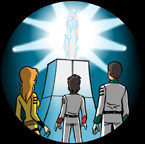
The Space Battleship Yamato feature film, released in 1977, condensed the first TV series into a two-and-a-half hour movie. The TV version, broadcast a year later, gave us an alternate ending in which the crew arrives at Iscandar only to learn that Starsha and her people are long dead. Sadly, only a hologram is there to greet them. Thus does this unique version of the film become the first “alternate universe” scenario in a Yamato production.
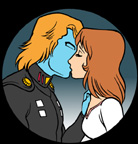
What’s this? Yuki Mori (Nova) plants a big one on the lips of Dark Nebula Lieutenant Alphon? Well, maybe. This image is derived from a scene that was “secretly” animated for Be Forever Yamato but cut from the film. In fact, the scene wasn’t even in the script. One animator just thought it ought to happen and drew it on his own. We can only wonder how it might have changed the story.
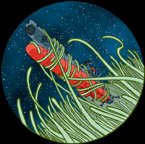
A living planet ensnares the Yamato. This concept was cooked up for Series 3 but was lost when the show was reduced from 52 episodes down to 25. It survives only in a toned-down form in the Planet Phantom episodes. The idea of a planet-sized life form was actually conceived as a possible threat in New Voyage, but in that case as well, the idea didn’t make it to the final script.
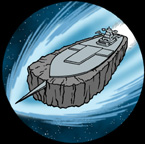
Before Leiji Matsumoto joined the production staff, Yamato went by the name Icarus and looked very different from the ship we know and love. For starters, it was encased inside a giant rock that served as armor against its enemies (aliens named the “Rajendora”) and was manned by an international crew. How might all our lives be different now had Icarus made it to TV?
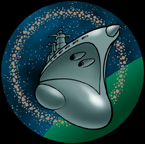
It was Leiji Matsumoto’s idea to abandon the flying-rock-in-space concept, but there was still some design work between that and the Space Battleship that has since become an icon the world over. This iteration of Yamato probably came just before the concept of a wave-motion gun.
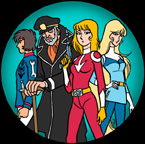
Every anime series goes through a long period of design development before its final images are chosen. When re-examining the discarded designs after the fact, you can’t help but wonder what directions the story might have taken with these “alternate universe” characters at the helm. Here, from various design stages, are Wildstar, a very Ahab-looking Avatar, and Nova from Series 1. On the right is an early Sasha (from Be Forever).

Dessler (Desslok) went through many of his own design changes before settling into the one we know today. Here’s an intriguing version from about halfway through the process, showing some wilder roots that were entirely consistent with other anime villains from the early 1970s. Considering these commercial pressures, it was almost revolutionary for Dessler to end up as refined as we finally saw him.
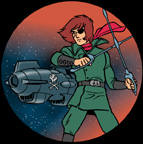
As has been well-documented, Leiji Matsumoto’s most famous original character, Captain Harlock, was to appear in the first Yamato TV series. But his part was eliminated from the storyline when low ratings forced several episodes to be cut from production. Had he remained in the story, Harlock would have been just as pivotal a character as Dessler. This image depicts an amalgam of several different Harlock designs that were developed in pre-production.
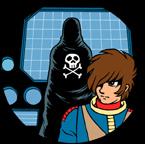
Although Harlock didn’t make it to television in Yamato (getting his own series a few years later instead), he did make it into Leiji Matsumoto’s manga version, albeit under a ghostly shroud. This version predated the Space Pirate TV series by over three years and was meant to be Mamoru Kodai (Alex Wildstar) traveling undercover as a sort of watchdog over Yamato’s mission. His true identity would not be revealed until the end of the story in his final showdown with Dessler.
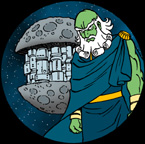
Here’s an early design for Zordar and space fortress Gatlantis, the White Comet Empire City. Both went through many design changes during the development of Farewell to Yamato, starting from the concept of a Greek or Roman-style emperor and gradually evolving into the Zordar we know and loathe. Gatlantis, meanwhile, was simply sliced in half after it reached this stage.
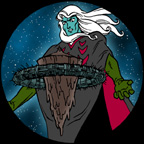
Here’s an early design that evolved into Emperor Lugal of the Dengil Empire in Final Yamato, and a proto-version of City Satellite Uruk. Like the early Zordar, it’s apparent that the design staff still had Greco-Roman styles in mind at the start of the process.
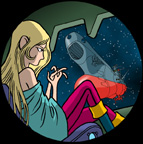
Between his manga versions of Series 1 and Farewell to Yamato (which remains incomplete to this day), Leiji Matsumoto took some time out to write and draw a wholly original episode focusing on this character, Jura. She lives on a desolate planet with her mother Mela, who conducts a psycho-battle against the Yamato crew, filling their heads with nightmare visions. Although practically unkown to US fans, Jura is a well-regarded member of the Yamato pantheon by Japanese fans. An English translation of this manga, Eternal Story of Jura, can be found here.
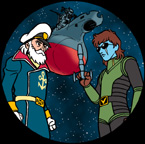
Another artist who brought Yamato to the manga page was Akira Hio, who adapted series 1 and all the movies. Although most of his work follows the anime scene for scene, his adaptation of series 1 is an important exception. Because it was done while the TV series was still in production, Hio included several concepts that would later be cut from the anime version, giving us a unique window into what might have been. Here is Hio’s version of Okita (Avatar) squaring off against Domel (Lysis).
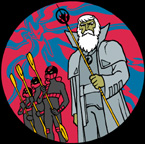
In the late 1980s, a US comic book publisher named Comico briefly owned the rights to Star Blazers and published two miniseries. This image, derived from the first series, depicts General Radnar and his troops who zealously follow their Goddess Arishna and make all sorts of trouble for both Desslok and the Star Force. Thanks to Star Blazers superfan Fred Kopetz for reference material on this one.
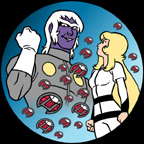
This one is based on the one and only Star Blazers fan film, Desslok’s Revenge. This fully-animated 30-minute adventure was written and directed in 1986 by Brian Cirulnick. Though the film is named for Desslok, his “revenge” takes a back seat to young Gwendoline Stiers, who stows away on the Argo to later save the entire crew from destruction by the Andromeda Empire. Desslok’s Revenge was never distributed outside fan-trading circles. Special thanks to Jeff Blend for supplying a copy for this effort.
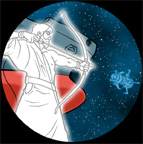
This image was suggested by Ande Lyon, who responded to my request for fan authors to contribute. Ande writes Star Blazers fanfic under the name “Wicked Good Grrrl” at the Visions website. She explains: “this was inspired by the encyclopedic Man, Myth and Magic’s article on Avatar, and by the character of Arjuna from the Hundu epic Mahabarata.” As a spectral archer, Captain Avatar here personifies the Argo’s reflective energy being used against Desslok’s final attack in Series 1. Ande’s work can be found at here.
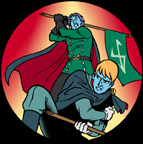
Chris Morin is a long time Star Blazers/Yamato fan, and has been writing his own stories since 1991. This image of Desslok having a disagreement with one of his generals is a scene from Chris’ second Star Blazers story, titled “Circle Of Death.” It can be read at here.
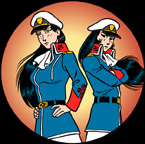
Here’s a fanfic image inspired by writer Susan Moore, who had been doing other stories for several years and decided to write one for Star Blazers. Susan explains: “I wrote a story about Nova having friends who were twin sisters in the EDF, one of whom had been a love interest to Sandor.” Susan’s author name is “Darkrider62,” and her story can be found at here.

Here’s another fanfic image from a story called “The Rikasha Incident” by Fred Kopetz. Shortly after the Comet Empire’s invasion of Earth, a banished race of cyborgs returns to the Milky Way, where their new conquest to find their homeworld creates an alternate timeline. Here we see their Fortress bearing down on Earth to consume it for energy with only the Argo standing in their way. Fred’s story (and much more) can be found at his fanfic website here.
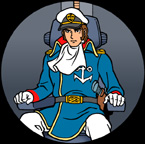
Mamoru Kodai (Alex Wildstar) takes command of the Yamato! This intriguing alternate scenario was used in the Japanese Playstation 2 version of Be Forever Yamato. With Mamoru taking the place of Captain Yamanami, it meant giving him command not only over his younger brother but also his daughter. I don’t know enough about the game to tell you if he meets the same fate as all the other Yamato captains, but the idea is certainly full of potential.
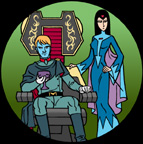
“One day, that will be mine,” Desslok thought to himself, eyeing the throne of Prince Zordar in episode 13 of Series 2. He did not, however, express any such ambition in Yamato 2, which makes this an idea unique to Star Blazers. I just had to see what he might look like in that throne with Invidia by his side, no doubt plotting against him at every turn.
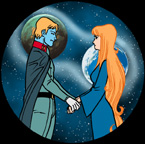
In The New Voyage we learn of Dessler’s love for Queen Starsha, forever unrequited. But in some alternate universe, perhaps this wasn’t the case. We can only speculate on how it might have changed him. Here’s one image of their togetherness…
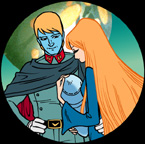
…and here’s another one, an alteration on a poster image created for The New Voyage. Here, Dessler stands in for Mamoru Kodai, which would make baby Sasha half Gamila/half Iscandarian. Another story with fantastic potential.
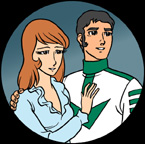
With his dying breath in Final Yamato, Shima (Mark Venture) confesses that he has secretly loved Yuki (Nova) since they first met, but he graciously stayed out of Kodai’s (Wildstar’s) way. Ignoring for a moment what an incredible guilt-bomb that would be to lay on your best friends, this image suggests a possible scenario in which Shima was less magnanimous.
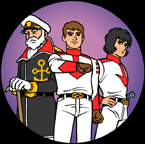
What if Captain Avatar hadn’t lost his son in the Battle of Pluto? What if instead he survived to become another member of the Star Force? We’d have to imagine that he’d get posted to the bridge, or at least be a very prominent figure in this alternate scenario. He would almost certainly be a chief rival with the hot-headed Derek Wildstar. This concept suggested by Star Blazers superfan Jeff Blend.
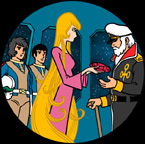
Also from the what-if-they-had-lived category comes this image of Sasha (sister to Queen Starsha) having survived her landing on Planet Mars to be escorted by Wildstar and Venture directly to Captain Avatar. It’s intriguing to wonder how the journey to Iscandar might have been different had she gone along for the ride. This concept also suggested by Star Blazers superfan Jeff Blend.
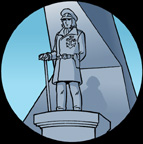
Swinging the pendulum the other way, what if a prominent character didn’t survive one of his adventures? Had Derek Wildstar followed the lead of other Captains and worn the “fatal hat” while in the “fatal chair,” he might very well have been given this Avatar-like monument on Hero’s Hill. Then again, this would probably happen even if he were to die a peaceful death. Yet another concept suggested by Star Blazers superfan Jeff Blend.
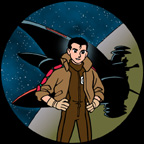
From speculative realms we move into those of actual sequels that got produced and released to Japanese audiences. Here’s the main character and the 17th Space Battleship Yamato from Yoshinobu Nishizaki’s Yamato 2520. Originally intended to run for 7 hour-long episodes, the project lost funding and was abandoned after episode 3 in 1994. But at least the ship got off the ground.
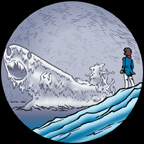
Leiji Matsumoto conceived Great Yamato in 2001, bringing the descendents of the original crew together in the year 3199 to revive the ship in time to destroy a black hole headed for Earth. (Sound familiar? The black hole threat was originally devised in 1993 for Yamato Resurrection.) The story made its debut as a manga and was followed by a modest product line that included an “image album” of music by Hiroshi Miyagawa.
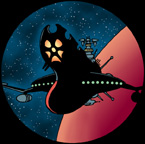
Dai Yamato Zero-Go was Leiji Matsumoto’s second attempt to bring Yamato back, this time in a highly altered form in a series of animated videos. Originally slated for five episodes, the series seems to have stalled at episode 3. However, this was enough to spawn a highly-popular pachinko slot game (the Japanese equivalent of pinball) and some attendent merchandise. For more on 2520, Great Yamato and Dai Yamato, click on those names right there.
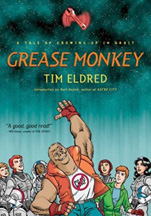
Okay, you got me. This isn’t a Yamato image, it’s the cover to my other favorite project, Grease Monkey. This graphic novel is available from all the major online booksellers, and it’s what I work on when I’m not doing Star Blazers. You can read all about it (and even see some free color comics) here
